I first started writing gear reviews on a couple of different internet forums back in the day because I got tired of reading a bunch of articles that were obviously nothing more than a paid advertisement. I look at it this way: If I’m going to spend my hard-earned money on a piece of kit, I want it to work, work well, and work reliably. Window dressing doesn’t impress me, and while I like aesthetically pleasing equipment, I want substance.
Let’s get this out of the way right up front. I am not a fan of the custom pistol market, and I have maintained that for most normal folks like me, there is no reason to spend $2000 to "enhance" a $450 gun. I carry a Glock 17 for uniformed duty, and a Glock 19 or 26 when plainclothes, or off-duty. Due to department restrictions and regulations, I am not allowed to modify the internals of my handguns – so I understood the allure of tuning a pistol, just not to the tune of $2K.
I had an opportunity to meet Michael Parks from Agency Arms via an industry friend while at SHOT Show 2015. I, like others, had seen and heard the buzz about this new custom firearms company, and I had initially dismissed them as being another "bling bling" custom shop that emphasized flashy colors, stippling, and aggressive branding. I’ve shot a couple pistol models from some well known "enhancement" companies, but did not really see a huge improvement in my shooting, nor did I feel "enhanced" in any way shape or form, in fact, I felt that my speed and accuracy were pretty much comparable to my stock pistols that I use for work.
Michael, however, presented his new company well and I was intrigued by the work they were doing, and here’s why. Agency Arms seemed (at least with Michael’s presentation), to be much more than just another pretty face. Agency Arms brings forth a product that is not only aesthetically pleasing to the eye, but each and every cut, bevel, grind, and stipple is 100% function driven. Nothing fancy for the sake of being fancy, but useful modifications that are designed to enhance the shooter experience in a qualifiable way.
The Background
After SHOT Show 2015, I had an opportunity to tour Agency Arms HQ, and chat further with Michael Parks and Randy Niswander, the partners behind Agency Arms:
CT: Can you tell me a little bit about your background, how you got started, and your involvement in the industry?
RN: I started working with my Dad right out of high school as a Tool Maker/Machinist for a golf tooling company 29 years ago. 8 years later I had the opportunity to open up my own golf machining/mold company. After a few years NAFTA kicked in and I watched as the entire golf manufacturing industry shifted to Asia. To survive, I downsized and started over and decided to get involved in a more complicated, much less competitive area of machining. It was an expensive route, but one that eventually paid off.
I chose to stay small and specialize in complex computer modeling and 5 axis CNC machining and prototyping for the aerospace, commercial, film and automotive industries. Over the next 20 years I honed my skills at computer design, computer modeling and complex 3D machining.
Bringing what I have learned over the last 29 years to Agency Arms has helped us grow very quickly. At Agency Arms, all design, prototyping and production machining is done in house. That allows us to develop new products very quickly and better control the quality of our product.
MP: I served 5 years in the United States Marine Corps and served two deployments to Iraq. When I honorably discharged from the Marine Corps I began my law enforcement career in the Los Angeles area where I am currently assigned to patrol. These experiences gave me a unique insight on the need for dependable weaponry and equipment. Based on my experiences I began consulting for multiple tactical companies offering feedback and design critique for existing and future products. I brought this technical knowledge and networking to Agency Arms that has aided in our success.
CT: One of the things that immediately stood out to me about Agency Arms was that you guys are not shy about putting your product out there. Pricing sheets were available immediately, you all have a functional website, and you offer what almost seems like an a la carte menu of options for users.
For those that are new to Agency Arms, can you tell us about what features are on an Agency Arms pistol and the differences between slide models available?
MP: All of our slides have an RMR cut standard, and come with a "Battle Plate" that fills the void when the RMR is not installed. This plate is designed in a way that enables one hand manipulation of the firearm that increases safety. On our Battle Plate, the serrations and screw lugs are on the 45 angle cuts. Placing these serrations and lugs here, forces the shooter to angle the pistol away from the body when using one hand to rack the pistol.
"…forces the shooter to angle the pistol away from the body when using one hand to rack the pistol."
We have three versions of our slides, which are as follows:
- The Urban edition is the lightest slide we do. It has three windows and is best suited for no RMR due to weight and balance.
- The Field edition has no windows and is for the shooter who doesn’t like windows, or for the customer limited by department policy.
- The Hybrid edition has only one window on top of the slide and offers the best weight balance of the three configurations with an RMR installed.
Basically each edition is based on the intended use of the pistol.
CT: What about internals? For those that are concerned with the reliability of the gun, what modifications are done internally?
MP: We start by swapping out the recoil system with an ISMI (Integrated Systems Management, Inc.) stainless steel guide rod and flat wire recoil spring. We do not replace any springs in the trigger system. By not changing springs in the trigger system our pistols have consistent primer strikes and positive reset. We use a factory OEM minus connector and tune the factory trigger bar. With all this work the pull weight will be 4-4.25 pounds depending on the pistol. We also manufacture our own trigger shoe that is flat with a curved toe. This fixes the issue of trigger/trigger guard finger and glove bite.
CT: As beautiful and functional as the slide work is, in my opinion, the real beauty is in the framework. Can you talk about that?
MP: We remove the finger grooves, cut in gas pedals, and bevel out the inside area of the trigger guard on a mill. We call the gas pedals the "Accelerator Cuts" and they offer enhanced traction on the pistol. With the accelerator cuts, muzzle rise is dramatically decreased and follow up shots are faster. We do a non traditional double undercut and dock the front of the trigger guard for enhanced ergonomics. We finish the frame off with full stippling and offer Gen 4 back strap melding as well for no additional charge.
"…muzzle rise is dramatically decreased and follow up shots are faster."
CT: With all of this work that gets put into an Agency Arms pistol, what is your turnaround time?
MP: Turn around is 7-10 weeks for full builds and 3-4 weeks for frame builds.
CT: What’s next from Agency Arms? What can we expect to see from you guys in the future?
MP: We have numerous other projects in the works, but you’ll have to stay up to date on our social media.
The Rundown – Initial Impressions
While at SHOT Show 2015, I had an opportunity to shoot several different Agency Arms pistols during a private Agency Arms event, and I recently sent in my own project Gen4 Glock 17 for the Agency Arms treatment. I opted to go with the Field edition, as I wanted an enhanced performance pistol that was similar to my duty Glock 17; I don’t run an RMR, and for a carry/hard use gun, I didn’t want windows in the slide.
There were a couple of things that jumped out at me immediately while shooting a few of the models. I would have to say that far and away, the best enhancement to an Agency Arms pistol are the gas pedals or "Accelerator Cuts."
Many different custom companies will stipple the receiver forward of the slide lock area of the frame to provide traction and a grip texture for shooters that favor a thumbs forward grip – the idea being that additional traction in the stippled areas will provide not only a tactile reference point for shooter grip, but some additional control.
Agency Arms has taken that concept further by milling in a stepped platform for the shooter’s support thumb, providing a shelf to exert not only downward, but inboard pressure on the receiver; mitigating not only muzzle rise, but inward torque on the frame from less-than-straight-back trigger press. Different shooters have different preferences when it comes to how to grip a pistol, but regardless of one’s train of thought, the accelerator cuts will fit the bill.
Second? The trigger. It is rare that you’ll hear the words "crisp" and "Glock" mentioned in the same sentence, but the Agency Arms trigger is sweet. As Michael mentioned in the above interview segment, there are no secrets behind their trigger system; just some careful tuning and no overt monkeying around with the trigger system that could jeopardize reliability. The flat face trigger and toe make for a reliable and consistent trigger pull, and like the accelerator cuts, makes for consistently repeatable trigger contact. The trigger safety does not protrude as much as the standard Glock trigger, and it is far less noticeable on the trigger press.
In my initial testing, the Field edition is out-of-the-box reliable. I did not clean or lube it once it came back to me, and at first opportunity to take it out to shoot it, I promptly threw it in a mud puddle first. At the completion of this article, I only have 350+ rounds through it, but my Agency Arms Field edition has maintained its Glock reliability. No hiccups, malfunctions, misfires, light strikes, or any issues whatsoever other than my sights were drastically off zero upon return. That for me is no big deal as I swapped the crappy plastic factory Glock sights for a set of fiber optic 10-8 Performance sights, but I would recommend that end users check zero on their Agency Arms pistols before taking it out into the field for real-world excursions.
My follow-up article will be a little more in depth after I up the round count; I won’t make any hard assessments about the Agency Arms platform until I have a bit more trigger time. Look for a follow-up article to be published in the fall where I will discuss wear, reliability, as well as impressions of several of the Agency Arms features; do their claims hold up in real use application? We’ll see how it goes. Until then, be sure to check in with me on YouTube and Facebook where I will continue to upload short video clips of my Agency Arms Field edition in action, as well as quick tests of the pistol functions.
Visit Agency Arms here: Agency Arms and Facebook.
Visit Chris Tran here: Facebook, Instagram, and YouTube.


* The views and opinions expressed on this web site are solely those of the original authors and contributors. These views and opinions do not necessarily represent those of Guns & Tactics Magazine, the administrative staff, and/or any/all contributors to this site.






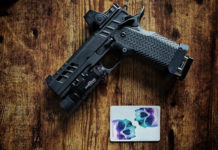
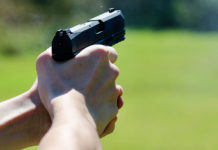
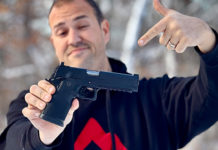
![Vudoo Gun Works Möbius 1911 [Video] Vudoo-Gunworks-1911](https://www.gunsandtactics.com/wp-content/uploads/2022/10/Vudoo-Gunworks-1911-218x150.jpg)
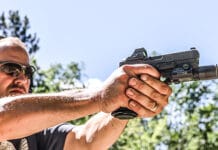
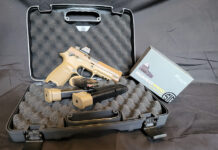

[…] I first started writing gear reviews on a couple of different internet forums back in the day because I got tired of reading a bunch of articles that were obviously nothing more than a paid advertisement. I look at it this way: If I’m going to spend my hard-earned money on a piece of […] …read more […]
Comments are closed.